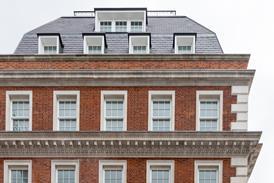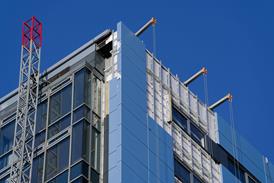A closer look reveals that, apart from the bright yellow doors, most of the single-storey wing on the right is not new at all. In fact, the bulk of the building, behind and to the right of two new extensions, is a standard system-built school designed and erected in the 1960s by the former Inner London Education Authority.
As the stylishness of the refurbishment by Shepheard Epstein Hunter suggests, architectural design was assigned a key role in the project from the start by the education authority, Lambeth council. Kings Avenue is the first of four "landmark" schools to be completed as part of Lambeth's primary school development strategy, in which architects, including Penoyre & Prasad and Allford Hall Monaghan Morris, were selected for their inspired architectural design. To help guide these designs through the thickets of bureaucracy and legislation, Lambeth appointed Britain's doyen of school design, Sir Colin Stansfield Smith, former chief architect of Hampshire council, as design mentor to the consultant architects.
But Lambeth's primary school development strategy runs deeper than the application of voguish styling. The four new schools are the product of a rationalisation process in which 10 schools were amalgamated and four sites sold to fund £16m worth of improvements to the remaining buildings.
The rationalisation was in response to the borough's declining child population, which, by 1999, had left the council struggling under the weight of one of the highest educational budgets in the country while it operated at 17% below capacity. Funding through site disposals had the benefit of side-stepping PFI procurement and opening up a more direct relationship between architect on the one side and the head teacher and governors on the other.
Radical approaches to education are at the core of the four developments. As well as IT teaching aids, principally electronic whiteboards that operate like giant touchscreen computer monitors, and ubiquitous category five IT cabling, all new classrooms and all existing ground-floor ones now open on to outdoor teaching rooms.
The education policies have strong social aspects. Kings Avenue School will stay open after school hours to provide lifelong learning to the local community. More radically, children with special educational needs will be included in mainstream classes. In particular, the school has been designated a centre for excellence for visually impaired pupils.
As a result of the amalgamations, Kings Avenue School has been boosted in size from two to three classes for each year group, and this has required eight more classrooms. To cater for the new educational and social requirements, the 1960s building has been remodelled and upgraded internally, and the entrance link block largely rebuilt.
In Shepheard Epstein Hunter's design, the eight classrooms have been added in the form of two extensions to the front of the old two-storey juniors block and the single-storey infants block. Facing the street, they present a smart frontage that conveniently masks most of the 1960s building behind, whose primitively repetitive industrialised facade was rendered twice as dismal by its chocolate-brown colouring.
However, an architect's natural inclination to have the new buildings turn their backs on the old ones was kept in check by Stansfield Smith. "He nudged us towards using the new blocks to revive the old architecture rather than fight against it," says Steven Pidwill, director of Shepheard Epstein Hunter. In any case, the £2.4m budget did not stretch as far as an external makeover of the old buildings.
Accordingly, the single-storey extension has been aligned along the same frontage as the old single-storey wing, and its window pattern follows a similar rhythm. Other common features include the new yellow doors, which help civilise the 1960s wing.
The biggest design challenge was to incorporate facilities for children with special educational needs that would be effective, but subtle enough not to stigmatise the school. Long consultations took place with the assistant head teacher, Kirsten Arthur, who heads a special inclusion team of teachers and therapists in the school, and with experts from the Royal National Institute for the Blind and the Department for Education and Skills. Pidwill notes: "A style emerged of how to cater for special needs children."
One solution was to dedicate certain rooms alongside mainstream classrooms as "personal care suites" for those with special educational needs. The children are encouraged to attend mainstream classes with the other pupils, but can withdraw to their own bases if they feel overwhelmed.
A design report for the school noted that nearly all the children with visual impairment can see something and have heightened sensitivity to stimuli such as light, sound, texture, colour and geometry. This understanding led to the inclusion of extensive sensory aids to make the whole building more accessible. The most obvious move was to raise the level of daylight in the school.
In the new wings, this was provided by large windows supplemented by clerestories beneath high ceilings and small low-level windows to give glimpses outside.
Upgrading daylighting and providing a clear sense of orientation was more difficult in the old building, with its deep plan and low ceilings. It was also more urgent, as Pidwill recalls the "feeling of lethargy creeping over you" in the building.
The original school was inexplicably laid out in an open plan format, and the solution was to create a network of corridors through it. The corridors are lit by rooflights, and windows in the new partitions keep visual contact with the classrooms. Each corridor ends in a glazed external door, so that children can orientate themselves in relation to the outdoors. In the studded vinyl flooring, a continuous stripe changes colour as it progresses to serve as a route map through the building. In places, the corridors widen out to provide ancillary teaching spaces for small groups.
Many other devices, several quite subtle, aid access and orientation. Walls have been painted in range of bright colours, light natural timber doors stand out against darker door frames and silvery metal door handles are made more conspicuous by small black disks fixed around their mounting.
The most radical remodelling has been carried out on the single-storey link block containing the main entrance. The aim was to make the reception more welcoming to the whole community with a larger front window, while replacing a short flight of steps in the corridor behind it with a more accessible ramp. As these elements could not be fitted into the existing shell, it was demolished and rebuilt beneath a monopitch steel standing-seam roof. The reception is now fronted by a large open counter set in a purple-coloured wall, which, as Pidwill points out, is a far cry from the old sliding window.
Head teacher Frances McGregor can't wait to move into the refurbished building. "The feedback we have been getting is that people are astounded by how much we are doing to include pupils with special educational needs within mainstream classes. This should snowball once we move into the new building. And I expect the children will enjoy it immensely."
Downloads
Cutaway 3D diagram of enlarged school
Other, Size 0 kb
Credits
client Lambeth council architect and landscape architect Shepheard Epstein Hunter structural engineer John Savage Associates services engineer GW Consulting quantity surveyor Faithful & Gould main contractor Buxton























No comments yet